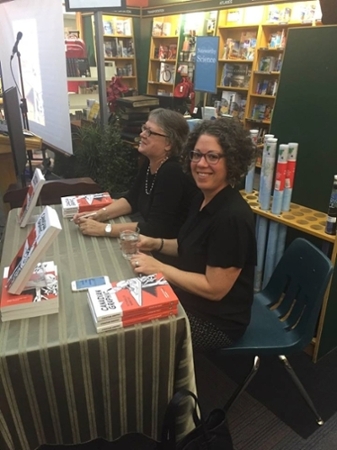Candida Rifkind Co-Edits Canadian Graphic: Picturing Life Narrative
Thu. Oct. 6, 2016
 Candida Rifkind Co-Edits Canadian Graphic: Picturing Life Narrative
Candida Rifkind Co-Edits Canadian Graphic: Picturing Life Narrative
Canadian Graphic: Picturing Life Narratives. Edited by Candida Rifkind and Linda Warley, published by Wilfrid Laurier University Press, 2016.
“Canadian cartoonists have been at the forefront of the alternative comics (as opposed to superhero or mainstream) scene for several decades.” Candida Rifkind
Candida Rifkind, an award-winning author and professor of English here at UW, has very recently published a new book in the Wilfrid Laurier Press “Life Writing Series.” Canadian Graphic is a multi-faceted anthology of essays about alternative Canadian comics and graphic life narratives. The collection includes Candida’s essay about Ho Che Anderson’s King – a hard-edged and stylish graphic biography of Martin Luther King.
This collection also features chapters by two other English Department faculty. Doris Wolf has contributed to Canadian Graphic with an essay about David Alexander Robertson’s graphic novels, which variously approach Indigenous life narratives. And Kathleen Venema has written about the work of Sarah Leavitt, whose work, Tangles, takes on the artist’s relationship with her mother’s Alzheimer’s.
The essays in Canadian Graphic are innovative, comprehensive, eloquent, and accompanied by illustrations.
We have asked Candida Rifkind briefly to give us some idea of the range and subtleties of this anthology.
Q: What are graphic life narratives?
A: Graphic life narratives are autobiographies, biographies, memoirs, diaries, and other genres of life writing in the form of comic books. While they are sometimes referred to as “graphic novels,” we avoid this term because the works in this volume are not (or not entirely) fiction; they are narratives based on real people’s life stories – either their own or someone else’s. As the field of comics studies has grown into a vibrant discipline of academic study, there has been a tendency to privilege “autographics,” or autobiographical comics. We agree that works such as Art Spiegelman’s Maus, Marjane Satrapi’s Persepolis, and Alison Bechdel’s Fun Home are landmarks of “serious” comics. But we also wanted to expand beyond autobiography to include biography, confessions, and even semi-fictional autobiographies in which the cartoonist is represented by an avatar. Including these other forms of graphic life narrative in this collection showcases the variety of styles and stories cartoonists are producing in Canada.
Q: Who are some of the Canadian writers and illustrators whose work is examined in this book?
A: One reason we specifically wanted to focus on Canadian graphic life narratives is because Canadian cartoonists have been at the forefront of the alternative comics (as opposed to superhero or mainstream) scene for several decades. The volume includes chapters on some of the first generation of Canadian alternative cartoonists, such as Chester Brown, Seth, and Julie Doucet. But we are also excited to include scholarship on younger and emerging cartoonists, including Scott Chantler, Sarah Leavitt, David Alexander Robertson, and Ho Che Anderson.
Q: For whom is this book published?
A: We want this book to appeal to students, scholars, and the general public, especially alternative comics fans. We tried to keep the jargon to a minimum yet maintain a standard of scholarly rigour, so that anyone who loves comics and graphic narratives will find it accessible.
Q: What is it about graphic narratives, especially graphic life narratives, that compels you?
I love reading all kinds of life narratives because I’m curious about real people’s experiences, and how writers and artists represent themselves to their readers. Graphic life narratives are especially interesting because the cartoonist must not just tell a life story, they must picture it too; they must draw themselves over and over again, which requires imagining how they look to others and reconciling that with their self-perception. And they can use all the visual resources of cartooning, from caricature to integrating other media such as photographs, scrapbooks, and documents, to paint a richer portrait of their lives.
I’m particularly interested in graphic biography because in that genre cartoonists have to imagine another person’s life narrative and either draw on or subvert how they have previously been represented, both verbally and visually. Comics is a form of fragments – individual panels combine into a whole story – and so it is an ideal aesthetic to depict the individual moments in people’s lives that combine into a complex narrative of their experiences.
Pictured above: Candida Rifkind and Linda Warley at the launch of Canadian Graphic at McNally Robinson Grant Park (photo by Andrew Burke)